| |
The
Seventh Annual Guelph Jazz Festival
Guelph ON, 6-10 September 2000
by Frank Rubolino
September 2000
 The
Guelph Jazz Festival continues each year to expand its breadth while
quietly competing very effectively with festivals of much larger size
and budget. In this, its seventh year of operation, it again presented
an exciting array of international musicians, all of whom were showcased
at congenial venues over a five-day period. The locale is an amiable
college town situated about 50 miles west of Toronto. The festival
makes use of university and community facilities to showcase its agenda
of creative and cutting-edge performers. Its programs are well spaced
to preclude it being a marathon event, and the ambiance of the surroundings
is conducive to the creativity that ensues. In addition, the festival
fosters a colloquium where panelists and speakers consisting of educators,
writers, and musicians are offered the opportunity to expound on the
cultural, economic, and social aspects of the music. The 2000 colloquium
was titled Improvising the Future: Jazz in the Global Community
and featured four panel discussions, two keynote speakers (trombonist
George Lewis and educator George Elliott Clarke), three workshops,
a dozen formal treatises, and a roundtable forum intertwined among
the performances. The community atmosphere at Guelph is pervasive
and very conducive to the musical and educational vibrations that
permeate the air at this delightful late-summer site. The musical
portion of the Festival began on Wednesday night: The
Guelph Jazz Festival continues each year to expand its breadth while
quietly competing very effectively with festivals of much larger size
and budget. In this, its seventh year of operation, it again presented
an exciting array of international musicians, all of whom were showcased
at congenial venues over a five-day period. The locale is an amiable
college town situated about 50 miles west of Toronto. The festival
makes use of university and community facilities to showcase its agenda
of creative and cutting-edge performers. Its programs are well spaced
to preclude it being a marathon event, and the ambiance of the surroundings
is conducive to the creativity that ensues. In addition, the festival
fosters a colloquium where panelists and speakers consisting of educators,
writers, and musicians are offered the opportunity to expound on the
cultural, economic, and social aspects of the music. The 2000 colloquium
was titled Improvising the Future: Jazz in the Global Community
and featured four panel discussions, two keynote speakers (trombonist
George Lewis and educator George Elliott Clarke), three workshops,
a dozen formal treatises, and a roundtable forum intertwined among
the performances. The community atmosphere at Guelph is pervasive
and very conducive to the musical and educational vibrations that
permeate the air at this delightful late-summer site. The musical
portion of the Festival began on Wednesday night:
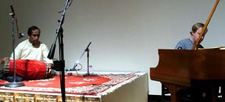 The high
ceilings and hardwood floors of the Macdonald Stewart Art Centre provided
excellent acoustical balance to promote this union of jazz piano and
South Indian percussion. Paul Plimley and Trichy Sankaran played a
stimulating duet that embraced the ritualistic and fast moving dance
of the Indian culture as it overlapped gracefully with the jazz aesthetic.
Evoking spontaneous and highly intricate Karnataka rhythm patterns
from two traditional South Indian instruments, the double-ended mridangam
and the small-framed kanjira, Sankaran set a pulsating pace to encourage
Plimley to prance in cat-like manner over the resonating keys. Plimley's
often-percussive piano style is quite complementary to the playing
of Sankaran. He picks up the signal from a few beats and proceeds
to develop it into an engrossing exploration of the music's core.
This was demonstrated throughout the program, but it also became the
feature of an extended call and response conversation. Sankaran produced
a wide array of rhythms that cajoled Plimley into making involved
statements as an answer to the tease. The empathy demonstrated between
these two was boldly on display as each musician used threads of the
other's output to expand their creative energies. Sankaran had the
spotlight frequently and awed the crowd with his lightning-fast fingering
as he meted out talas of repeated time units with differing degrees
of stress to form a cyclical pattern. This project is a challenging
alternative in the creative sphere of Plimley, who subtly instilled
his own Western dynamics into a program filled with uniqueness. It
was a joyous festival opening. The high
ceilings and hardwood floors of the Macdonald Stewart Art Centre provided
excellent acoustical balance to promote this union of jazz piano and
South Indian percussion. Paul Plimley and Trichy Sankaran played a
stimulating duet that embraced the ritualistic and fast moving dance
of the Indian culture as it overlapped gracefully with the jazz aesthetic.
Evoking spontaneous and highly intricate Karnataka rhythm patterns
from two traditional South Indian instruments, the double-ended mridangam
and the small-framed kanjira, Sankaran set a pulsating pace to encourage
Plimley to prance in cat-like manner over the resonating keys. Plimley's
often-percussive piano style is quite complementary to the playing
of Sankaran. He picks up the signal from a few beats and proceeds
to develop it into an engrossing exploration of the music's core.
This was demonstrated throughout the program, but it also became the
feature of an extended call and response conversation. Sankaran produced
a wide array of rhythms that cajoled Plimley into making involved
statements as an answer to the tease. The empathy demonstrated between
these two was boldly on display as each musician used threads of the
other's output to expand their creative energies. Sankaran had the
spotlight frequently and awed the crowd with his lightning-fast fingering
as he meted out talas of repeated time units with differing degrees
of stress to form a cyclical pattern. This project is a challenging
alternative in the creative sphere of Plimley, who subtly instilled
his own Western dynamics into a program filled with uniqueness. It
was a joyous festival opening.
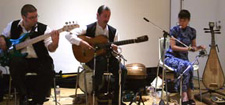 Thursday's
activities began with ASZA, a collective representing multiple cultures
linked by a common thread through the language of world music. They
engulf the stage with a vast array of strange-looking and unconventional
instruments and proceed to make highly rhythmic and spontaneous music
that reflects the totality of their worldly experiences. Although
all musicians appear to have equal standing in the group, Randy Raine-Reusch
is the spokesperson and effective leader. He coaxes amazing sounds
from his 21-string Asian zither, saw, and numerous other wind and
percussion instruments. Raine-Reusch explained that he does not simply
play these exotic music makers—he first absorbs the culture
of their origin and studies with local experts to master them. His
exotic sounds blend gently with the oriental music from Qiu Xia He's
Chinese pipa, an ancient string instrument that she manipulates with
high dexterity. Folding in the heartbeat of South America and the
other continents is Pepe Danza, a powerful Uruguayan percussionist
and shakuhatchi player who visually and aurally dominates the soundstage.
The impact of Southern and Eastern Europe is provided through André
Thibault on flamenco guitar or the oud, another ancient string instrument.
Guest musician Mark Rodgers inserted the bass line, and the five artists
took the crowd on a whirlwind journey around the world, with stops
in Spain, India, China, Japan, South America, Thailand, North Africa,
Eastern Europe, and others. The exciting element in ASZA's music is
its integration of multiple ethnic and cultural rhythms, melodies,
and improvised enthusiasm into a collage representing a homogeneous
whole. ASZA is a wonder to watch and hear. They captivated the crowd
with their infectious beat and creative skill. Thursday's
activities began with ASZA, a collective representing multiple cultures
linked by a common thread through the language of world music. They
engulf the stage with a vast array of strange-looking and unconventional
instruments and proceed to make highly rhythmic and spontaneous music
that reflects the totality of their worldly experiences. Although
all musicians appear to have equal standing in the group, Randy Raine-Reusch
is the spokesperson and effective leader. He coaxes amazing sounds
from his 21-string Asian zither, saw, and numerous other wind and
percussion instruments. Raine-Reusch explained that he does not simply
play these exotic music makers—he first absorbs the culture
of their origin and studies with local experts to master them. His
exotic sounds blend gently with the oriental music from Qiu Xia He's
Chinese pipa, an ancient string instrument that she manipulates with
high dexterity. Folding in the heartbeat of South America and the
other continents is Pepe Danza, a powerful Uruguayan percussionist
and shakuhatchi player who visually and aurally dominates the soundstage.
The impact of Southern and Eastern Europe is provided through André
Thibault on flamenco guitar or the oud, another ancient string instrument.
Guest musician Mark Rodgers inserted the bass line, and the five artists
took the crowd on a whirlwind journey around the world, with stops
in Spain, India, China, Japan, South America, Thailand, North Africa,
Eastern Europe, and others. The exciting element in ASZA's music is
its integration of multiple ethnic and cultural rhythms, melodies,
and improvised enthusiasm into a collage representing a homogeneous
whole. ASZA is a wonder to watch and hear. They captivated the crowd
with their infectious beat and creative skill.
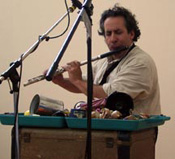 Yet
still another blending of cultures was represented by the duet performance
between French Canadian reed player Jean Derome and Chinese Canadian
pianist Lee Pui Ming. Derome brought with him a bevy of toys and small
wind and percussion objects to augment his reeds. He opened the program
making arrhythmic sounds and strange noises by squeezing, whirling,
striking, blowing, or otherwise simply toying with all the paraphernalia
in his bag of tricks. This playful musicality evolved into a spirited
and liberated reed/piano duet by these two contrasting yet compatible
artists. Lee can be delicate or aggressive with her piano as she often
allows her Western influences to take precedence over Oriental musical
concepts. Yet, there were moments when her Chinese background formed
the basis for an entire sonic segment. She scurried over the keys
at quick-time pace to match the high-pitched shrills from Derome's
flute. Her playing exhibited a sense of spirited zeal as she filled
the session with dynamic highs and occasional bombastic pounding.
Lee as well came equipped with assorted gadget noisemakers. Derome
was at his creative best on alto. He wrenched torturous tones from
the upper and lower register while establishing a hectic feeling of
urgency. These passages were followed by other exercises in manipulation
of his table of sound-producing accessories. Both performers were
highly emotional and emphatic in outwardly expressing a communion
of spirits. Whether on traditional instruments or makeshift utilities,
they were enthusiastically received by the crowd. Yet
still another blending of cultures was represented by the duet performance
between French Canadian reed player Jean Derome and Chinese Canadian
pianist Lee Pui Ming. Derome brought with him a bevy of toys and small
wind and percussion objects to augment his reeds. He opened the program
making arrhythmic sounds and strange noises by squeezing, whirling,
striking, blowing, or otherwise simply toying with all the paraphernalia
in his bag of tricks. This playful musicality evolved into a spirited
and liberated reed/piano duet by these two contrasting yet compatible
artists. Lee can be delicate or aggressive with her piano as she often
allows her Western influences to take precedence over Oriental musical
concepts. Yet, there were moments when her Chinese background formed
the basis for an entire sonic segment. She scurried over the keys
at quick-time pace to match the high-pitched shrills from Derome's
flute. Her playing exhibited a sense of spirited zeal as she filled
the session with dynamic highs and occasional bombastic pounding.
Lee as well came equipped with assorted gadget noisemakers. Derome
was at his creative best on alto. He wrenched torturous tones from
the upper and lower register while establishing a hectic feeling of
urgency. These passages were followed by other exercises in manipulation
of his table of sound-producing accessories. Both performers were
highly emotional and emphatic in outwardly expressing a communion
of spirits. Whether on traditional instruments or makeshift utilities,
they were enthusiastically received by the crowd.
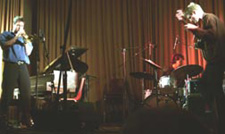 The
Toronto-based trio of Jean Martin was a pleasant surprise for me,
given that I had not been previously exposed to their stirring brand
of music that mixed structure with openness to achieve a satisfying
composite. Martin propels the group from his drum chair, using either
subtle colorings of asymmetric rhythm or more demonstrative blasts
to incite trumpeter Kevin Turcotte and guitarist Justin Haynes into
flights of eccentricity. The compositions were melodic benchmarks
designed to establish a foundation from which Turcotte and Haynes
could rise to seek the unregulated potential of the tunes. Haynes
used real-time electronic feedback of his bent and twisted guitar
notes to supplement his playing and to spread a spooky aura over the
set. His redistributed notes echoed and competed with his newly imputed
expressions and the trumpet probes of Turcotte. Turcotte is a very
expressive player. He swirls his notes around and around the melody
much the way Dave Douglas does in establishing a beachhead. Starting
with basic melodic statements, he evolved the tunes into more elaborate
pieces where all three musicians could collectively respond. Behind
it all, Martin unassumingly maintained control as the prime mover
of the set. The use of electronics with this music was very tastefully
done and added to the prevailing atmosphere of unusualness. The Martin
trio brought freshness, tension, and challenging music to the bandstand
on this night. The
Toronto-based trio of Jean Martin was a pleasant surprise for me,
given that I had not been previously exposed to their stirring brand
of music that mixed structure with openness to achieve a satisfying
composite. Martin propels the group from his drum chair, using either
subtle colorings of asymmetric rhythm or more demonstrative blasts
to incite trumpeter Kevin Turcotte and guitarist Justin Haynes into
flights of eccentricity. The compositions were melodic benchmarks
designed to establish a foundation from which Turcotte and Haynes
could rise to seek the unregulated potential of the tunes. Haynes
used real-time electronic feedback of his bent and twisted guitar
notes to supplement his playing and to spread a spooky aura over the
set. His redistributed notes echoed and competed with his newly imputed
expressions and the trumpet probes of Turcotte. Turcotte is a very
expressive player. He swirls his notes around and around the melody
much the way Dave Douglas does in establishing a beachhead. Starting
with basic melodic statements, he evolved the tunes into more elaborate
pieces where all three musicians could collectively respond. Behind
it all, Martin unassumingly maintained control as the prime mover
of the set. The use of electronics with this music was very tastefully
done and added to the prevailing atmosphere of unusualness. The Martin
trio brought freshness, tension, and challenging music to the bandstand
on this night.
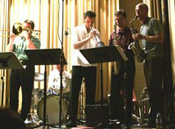 Misha
Mengelberg made a return trip to the Guelph Festival, but this time
he brought with him the entire ICP Orchestra. This group has a reputation
for having fun on the bandstand, yet on this night, they got down
to serious business and kept the intensity at a high level throughout
their extended set. As though to allow Han Bennink a chance to expel
his pent-up aggression, Mengelberg scheduled him to open the concert.
He played a bombastic solo filled with the energy and fury for which
he is noted. Enter the full band, which casually segued into the melodic
Mengelberg tune "A Bit Nervous" to loosen up the audience for the
excitement to come. It came as a heavy downpour of cacophonous energy
corralled by the loosely controlled guidelines of Mengelberg. Ernst
Glerum and Ab Baars' freely improvised duet was the vehicle to set
an orbital path. The ICP is comprised of stars and each had his or
her moment in the sun, but Wolter Wierbos appeared to be the feature
of the evening. He brought muscular yet controlled fury to both his
ensemble and solo trombone playing. Michael Moore and Thomas Heberer
were also on prominent display. One of the band's most stirring selections
was a totally unique and freewheeling rendition of Ellington's "Caravan".
It allowed for much individual expression and would have gone on indefinitely
had not Mengelberg risen authoritatively to say "enough". A surprise
addition to the band was American expatriate Mary Oliver, who wielded
string enchantment, along with Tristan Honsinger and Glerum, as a
counterbalance to the often-dominant brass and reed assemblage. Mengelberg
himself had many featured solos where his pensive and probing approach
to the piano was on full display. The set was an enormous success
that seemed all too short despite its nearly 80-minute length. Misha
Mengelberg made a return trip to the Guelph Festival, but this time
he brought with him the entire ICP Orchestra. This group has a reputation
for having fun on the bandstand, yet on this night, they got down
to serious business and kept the intensity at a high level throughout
their extended set. As though to allow Han Bennink a chance to expel
his pent-up aggression, Mengelberg scheduled him to open the concert.
He played a bombastic solo filled with the energy and fury for which
he is noted. Enter the full band, which casually segued into the melodic
Mengelberg tune "A Bit Nervous" to loosen up the audience for the
excitement to come. It came as a heavy downpour of cacophonous energy
corralled by the loosely controlled guidelines of Mengelberg. Ernst
Glerum and Ab Baars' freely improvised duet was the vehicle to set
an orbital path. The ICP is comprised of stars and each had his or
her moment in the sun, but Wolter Wierbos appeared to be the feature
of the evening. He brought muscular yet controlled fury to both his
ensemble and solo trombone playing. Michael Moore and Thomas Heberer
were also on prominent display. One of the band's most stirring selections
was a totally unique and freewheeling rendition of Ellington's "Caravan".
It allowed for much individual expression and would have gone on indefinitely
had not Mengelberg risen authoritatively to say "enough". A surprise
addition to the band was American expatriate Mary Oliver, who wielded
string enchantment, along with Tristan Honsinger and Glerum, as a
counterbalance to the often-dominant brass and reed assemblage. Mengelberg
himself had many featured solos where his pensive and probing approach
to the piano was on full display. The set was an enormous success
that seemed all too short despite its nearly 80-minute length.
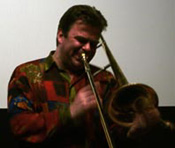 At
the midnight session held in a local movie theater, Wierbos picked
up as a soloist where he left off with the ICP. He played a short
but diversely interesting set. Initially he dismantled his trombone
and gave a clinic on blowing without the trombone sound—only
the swishing of his wind could be heard passing through his dismembered
horn. He then reassembled the instrument and began to emit short spurts
of sound to a rhythmic marching pattern he established in layers.
This gradually evolved into more clamorous playing where he sustained
a constant flow on ideas that appeared to pour effortlessly from his
horn. He invented theme fragments and discoursed off their lines with
multiple variations. A highlight was his dissertation on circular
breathing on the trombone, an exercise quite difficult to accomplish,
I am told. Wierbos played the range from gruff to smooth tones over
the entire sonic spectrum at this concert, and he communicated very
effectively with the attentive crowd. At
the midnight session held in a local movie theater, Wierbos picked
up as a soloist where he left off with the ICP. He played a short
but diversely interesting set. Initially he dismantled his trombone
and gave a clinic on blowing without the trombone sound—only
the swishing of his wind could be heard passing through his dismembered
horn. He then reassembled the instrument and began to emit short spurts
of sound to a rhythmic marching pattern he established in layers.
This gradually evolved into more clamorous playing where he sustained
a constant flow on ideas that appeared to pour effortlessly from his
horn. He invented theme fragments and discoursed off their lines with
multiple variations. A highlight was his dissertation on circular
breathing on the trombone, an exercise quite difficult to accomplish,
I am told. Wierbos played the range from gruff to smooth tones over
the entire sonic spectrum at this concert, and he communicated very
effectively with the attentive crowd.
Friday morning opened quite auspiciously with the keynote address
from George Lewis titled "The Old People Speak of Sound: Personality,
Empathy, Community" where he delved extensively into the origins of
the AACM and other topics of historical significance to the music.
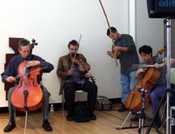 What
followed was billed as a workshop, but the appearance of Global Strings
turned out to be a high-quality performance. The Festival selected
nine string players from the various performing groups to play with
Plimley in a totally spontaneous and improvised set of sorcerous power.
Mat Maneri made his first appearance, while representatives from ASZA,
the ICP, the NOW orchestra, and Jason Stanyek (who on Wednesday presented
a paper on Pan African collaborations) displayed the art of listening,
interpreting, responding, extending, and embellishing the continual
string conversation that arced around the stage. Each artist instinctively
knew when to play and when to listen, while individual solos randomly
evolved into duets, trios, and more. Plimley punctuated their work
with sensitive statements, and eventually the entire group responded
in full chorus as violin, viola, zither, oud, cellos, birimbau, bass,
and pipa sang in joyous and soaring union. Stanyek remarked profoundly
at the closing, "That was an interesting way to get to know each other." What
followed was billed as a workshop, but the appearance of Global Strings
turned out to be a high-quality performance. The Festival selected
nine string players from the various performing groups to play with
Plimley in a totally spontaneous and improvised set of sorcerous power.
Mat Maneri made his first appearance, while representatives from ASZA,
the ICP, the NOW orchestra, and Jason Stanyek (who on Wednesday presented
a paper on Pan African collaborations) displayed the art of listening,
interpreting, responding, extending, and embellishing the continual
string conversation that arced around the stage. Each artist instinctively
knew when to play and when to listen, while individual solos randomly
evolved into duets, trios, and more. Plimley punctuated their work
with sensitive statements, and eventually the entire group responded
in full chorus as violin, viola, zither, oud, cellos, birimbau, bass,
and pipa sang in joyous and soaring union. Stanyek remarked profoundly
at the closing, "That was an interesting way to get to know each other."
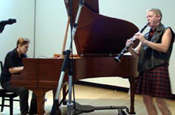 One
of the freest sets of improvised music came from Queen Mab, a Canadian
piano/reed duo who broke from the starting gate with shimmering flashes
of electricity to spark their communion. Lori Freedman, an aggressive
purveyor of spontaneity, alternated between clarinet and bass clarinet
while maintaining a consistently high level of nervous energy. She
was driven by the equally aggressive notes resounding from Marilyn
Lerner's piano. Lerner is an extremely accomplished pianist who comfortably
fits into many musical scenarios including klezmer music (she is the
pianist for From Both Ends of the Earth, which performed at an open-air
concert on Thursday), Cuban music, and other diverse contexts. On
this afternoon, however, she was a fully exploratory navigator probing
into the deep recesses of the piano. Although the songs were titled,
they came across as totally improvised expressions. Freedman coaxed
guttural blurbs from her bass clarinet and proceeded to take the instrument
into the stratosphere with high-pitched wails. On clarinet, she produced
the same liberated tonality as she wound her keening around Lerner's
single stabs or rich clusters of notes. The music was intense, often
yielding stark emissions of near hostility. It folded into layers
of textural tonality only to spurt off into robust rounds of adventurism.
Lerner toyed with the piano strings on "B Piece" and then became bombastic
in assaulting the keys. Freedman's tortured facial expressions signified
the total involvement she had with the music. Lerner and Freedman
produced exciting emotional music to captivate the opened-eared listener.
I was most impressed. One
of the freest sets of improvised music came from Queen Mab, a Canadian
piano/reed duo who broke from the starting gate with shimmering flashes
of electricity to spark their communion. Lori Freedman, an aggressive
purveyor of spontaneity, alternated between clarinet and bass clarinet
while maintaining a consistently high level of nervous energy. She
was driven by the equally aggressive notes resounding from Marilyn
Lerner's piano. Lerner is an extremely accomplished pianist who comfortably
fits into many musical scenarios including klezmer music (she is the
pianist for From Both Ends of the Earth, which performed at an open-air
concert on Thursday), Cuban music, and other diverse contexts. On
this afternoon, however, she was a fully exploratory navigator probing
into the deep recesses of the piano. Although the songs were titled,
they came across as totally improvised expressions. Freedman coaxed
guttural blurbs from her bass clarinet and proceeded to take the instrument
into the stratosphere with high-pitched wails. On clarinet, she produced
the same liberated tonality as she wound her keening around Lerner's
single stabs or rich clusters of notes. The music was intense, often
yielding stark emissions of near hostility. It folded into layers
of textural tonality only to spurt off into robust rounds of adventurism.
Lerner toyed with the piano strings on "B Piece" and then became bombastic
in assaulting the keys. Freedman's tortured facial expressions signified
the total involvement she had with the music. Lerner and Freedman
produced exciting emotional music to captivate the opened-eared listener.
I was most impressed.
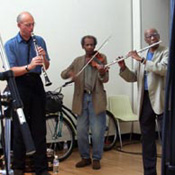 A
unique opportunity is afforded the Guelph Festival through its community
spirit, and it often manifests itself in the mixing and matching of
divergent talents into a meaningfully new assemblage. This happened
with the performance segment of the Jazz Cooperatives workshop that
paired three members of the AACM with an equal number from the ICP.
Although George Lewis explained that the two groundbreaking organizations
had very different cultural and social origins, the music has evolved
into a common concept where individual and group creativity is the
norm. This heady table of superstars played a freeform set where Leroy
Jenkins' weeping violin evoked spiritual flute and clarinet chirps
from Joseph Jarman and Michael Moore while Lewis puffed mellowly into
his trombone. With jarring suddenness, Han Bennink would insert bolts
of thunder to break the quietude and then allow the band to seek refuge
again in pastoral undertakings. Mengelberg added color as he gently
roamed the keyboard inserting pinpoint punctuation. He sashayed into
an introspective solo that was periodically awakened through Bennink's
cloudbursts, but then even Bennink became somewhat subdued in the
spirit of unity. Lewis could be heard playing fragments of Monk, and
Mengelberg tiptoed gingerly over the keys. Midway through the set,
all hands jumped into the fray and the temperature rose significantly.
Each player was fully expressive while simultaneously melding into
a unified entity. With an all-star cast such as this, you might have
expected to see egos emerge, but just the opposite happened. There
was a display of respect swirling around the sextet even when they
took the gloves off and did serious musical combat. This was probably
a once-in-a-lifetime chance to see these six musicians together. It
alone justified the pilgrimage to this festival, as Stuart Broomer
of Coda described such trips. A
unique opportunity is afforded the Guelph Festival through its community
spirit, and it often manifests itself in the mixing and matching of
divergent talents into a meaningfully new assemblage. This happened
with the performance segment of the Jazz Cooperatives workshop that
paired three members of the AACM with an equal number from the ICP.
Although George Lewis explained that the two groundbreaking organizations
had very different cultural and social origins, the music has evolved
into a common concept where individual and group creativity is the
norm. This heady table of superstars played a freeform set where Leroy
Jenkins' weeping violin evoked spiritual flute and clarinet chirps
from Joseph Jarman and Michael Moore while Lewis puffed mellowly into
his trombone. With jarring suddenness, Han Bennink would insert bolts
of thunder to break the quietude and then allow the band to seek refuge
again in pastoral undertakings. Mengelberg added color as he gently
roamed the keyboard inserting pinpoint punctuation. He sashayed into
an introspective solo that was periodically awakened through Bennink's
cloudbursts, but then even Bennink became somewhat subdued in the
spirit of unity. Lewis could be heard playing fragments of Monk, and
Mengelberg tiptoed gingerly over the keys. Midway through the set,
all hands jumped into the fray and the temperature rose significantly.
Each player was fully expressive while simultaneously melding into
a unified entity. With an all-star cast such as this, you might have
expected to see egos emerge, but just the opposite happened. There
was a display of respect swirling around the sextet even when they
took the gloves off and did serious musical combat. This was probably
a once-in-a-lifetime chance to see these six musicians together. It
alone justified the pilgrimage to this festival, as Stuart Broomer
of Coda described such trips.
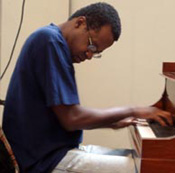 A
very intense and lengthy performance resulted from the duet of Matthew
Shipp and Mat Maneri. These two extremely serious artists joined forces
in probing the darker side of creativity. Shipp was at his ominous
best as he concentrated on the lower end of the keyboard to set the
somber tone. This contrasted well with the high-toned waves of string
sonority from Maneri's viola. They played what appeared to be a totally
improvised opening segment where individual expression merged to form
a complete picture much the way a jigsaw puzzle comes together. To
bring a point of reference to this improvised beauty, Shipp moved
the lengthy suite into "Greensleeves", where rich textures of the
song's foundation gave way to extended variations, with only micro-fragments
of the melody surfacing sporadically. Maneri was an intent listener
to the direction established by Shipp. He immersed himself in the
powerful rumblings from Shipp and added his own brand of spiritualism
with wildly emphatic strokes. When Shipp would move into the upper
register, Maneri tended to counterbalance the music with lower virtuosity.
They concluded the first opus with fragments of Monk, although it
was well disguised and uniquely Shipp/Maneri. The second piece opened
with Maneri soloing pensively, which allowed Shipp to enter with dynamic
cascades of notes. On this piece, Maneri seemed initially to be the
directional force, but the way Shipp molded his playing around the
strings made it a unitized body. Shipp then reassumed the pilot's
role and took the movement on a wild flight of droning left-hand rhythm
patterns spurred by Maneri's pickup of the theme. They wound this
portion of the long movement down gradually with near-melodic sensitivity
and a six-note repetitive rhythm, only to rise again for one last
hurrah of vigorous demonstrativeness. This was a draining intensive
on the art of improvisation that left the audience in awe. A
very intense and lengthy performance resulted from the duet of Matthew
Shipp and Mat Maneri. These two extremely serious artists joined forces
in probing the darker side of creativity. Shipp was at his ominous
best as he concentrated on the lower end of the keyboard to set the
somber tone. This contrasted well with the high-toned waves of string
sonority from Maneri's viola. They played what appeared to be a totally
improvised opening segment where individual expression merged to form
a complete picture much the way a jigsaw puzzle comes together. To
bring a point of reference to this improvised beauty, Shipp moved
the lengthy suite into "Greensleeves", where rich textures of the
song's foundation gave way to extended variations, with only micro-fragments
of the melody surfacing sporadically. Maneri was an intent listener
to the direction established by Shipp. He immersed himself in the
powerful rumblings from Shipp and added his own brand of spiritualism
with wildly emphatic strokes. When Shipp would move into the upper
register, Maneri tended to counterbalance the music with lower virtuosity.
They concluded the first opus with fragments of Monk, although it
was well disguised and uniquely Shipp/Maneri. The second piece opened
with Maneri soloing pensively, which allowed Shipp to enter with dynamic
cascades of notes. On this piece, Maneri seemed initially to be the
directional force, but the way Shipp molded his playing around the
strings made it a unitized body. Shipp then reassumed the pilot's
role and took the movement on a wild flight of droning left-hand rhythm
patterns spurred by Maneri's pickup of the theme. They wound this
portion of the long movement down gradually with near-melodic sensitivity
and a six-note repetitive rhythm, only to rise again for one last
hurrah of vigorous demonstrativeness. This was a draining intensive
on the art of improvisation that left the audience in awe.
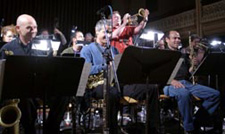 One
of the most risk-taking yet disciplined big bands today is Vancouver's
NOW Orchestra, which lends itself out to guest conductors to expand
its breadth and enlarge its sphere of musical knowledge. George Lewis
has been experimenting with this band for a number of years and was
invited to conduct his music on a tour with the band to Eastern Canada
that included the Guelph Festival. Lewis is an emotional and visual
conductor. He physically breaks out in a sweat as he animatedly brings
out nuances in the band's playing. Most NOW members are leaders in
their own right, but they suppress that role for the orchestra and
appear to receive great satisfaction from their collaborative efforts.
Lewis opened the program with his "Endless Shout" while establishing
a set-long pattern of featuring multiple band members as soloists
on each piece. Every musician excelled in his or her moment in the
spotlight. Lewis worked the band energetically, dividing them into
small groups while always returning to the huge ensemble sound. After
the rousing starter, Lewis presented an extended sequence of his "Shadowgraph"
music, offering five consecutive examples of the brooding and difficult
music. The entire series was a challenge to the band, yet on each,
individual play carried the day. This "Shadowgraph" series dates back
to Lewis's 1970s composing period and is extremely intense and demanding
music. It evolves with sudden turns, quick starts, and changing tempo
while always keeping the dense tonality as its identifier. It is atypical
big band music. The last scheduled tune was a return to rousing play
with Lewis'"Hello Goodbye" where the band was able to release pent
up energy. Of course, an encore was demanded and happily given by
the appreciative band so warmly received. Lewis did a wonderful job
of molding this orchestra, but his job was made much easier due to
the high caliber of musicianship exhibited by all. One
of the most risk-taking yet disciplined big bands today is Vancouver's
NOW Orchestra, which lends itself out to guest conductors to expand
its breadth and enlarge its sphere of musical knowledge. George Lewis
has been experimenting with this band for a number of years and was
invited to conduct his music on a tour with the band to Eastern Canada
that included the Guelph Festival. Lewis is an emotional and visual
conductor. He physically breaks out in a sweat as he animatedly brings
out nuances in the band's playing. Most NOW members are leaders in
their own right, but they suppress that role for the orchestra and
appear to receive great satisfaction from their collaborative efforts.
Lewis opened the program with his "Endless Shout" while establishing
a set-long pattern of featuring multiple band members as soloists
on each piece. Every musician excelled in his or her moment in the
spotlight. Lewis worked the band energetically, dividing them into
small groups while always returning to the huge ensemble sound. After
the rousing starter, Lewis presented an extended sequence of his "Shadowgraph"
music, offering five consecutive examples of the brooding and difficult
music. The entire series was a challenge to the band, yet on each,
individual play carried the day. This "Shadowgraph" series dates back
to Lewis's 1970s composing period and is extremely intense and demanding
music. It evolves with sudden turns, quick starts, and changing tempo
while always keeping the dense tonality as its identifier. It is atypical
big band music. The last scheduled tune was a return to rousing play
with Lewis'"Hello Goodbye" where the band was able to release pent
up energy. Of course, an encore was demanded and happily given by
the appreciative band so warmly received. Lewis did a wonderful job
of molding this orchestra, but his job was made much easier due to
the high caliber of musicianship exhibited by all.
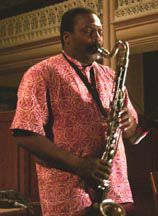 David
Murray is a wonder to hear and see perform. He exudes so much energy,
so much charisma, so much talent—it just spills over from his
commitment to the music. That inimitable sound that swells from his
tenor and bass clarinet was ever present on this night when he teamed
with Jon Jang. It was a very enticing union. Jang brings with him
a rich tradition of the social and cultural aspects of China, yet
he has adroitly managed to merge these musical qualities with Western
music. Several selections during the evening represented traditional
Chinese songs adapted to conform to the elements of improvised jazz.
Murray was a powerful force on this night. He opened on tenor with
ringing rounds of robust blowing while Jang pounded out a traditional
Chinese melody. The program contained a considerable measure of political
overtones. Murray's hauntingly beautiful tribute to Eleanor Bumpers,
an African American casualty in the war against police brutality,
was an emotional high that saw him consistently hitting gripping peaks
with raw conviction to free expression. Jang's solo on this piece
maintained the vital message as he built the tension for Murray's
reentry. Murray played a bass clarinet solo with his recognizable
tonguing technique and then smoothed out his motion with fluid blowing.
Jang followed with his own solo, the inspirational "You'll Never Walk
Alone", which he dissected convincingly with only a minimum of schmaltz.
Another moving piece was a dual composition on the same subject, the
injustice of capital punishment that Jang and Murray unilaterally
composed in protest to the death row imprisonment of Mumia Abu-Jamal.
They closed with the African American anthem "Lift Every Voice and
Sing" but did return for a short encore. Murray soared on high on
this captivating night, and Jang was a fitting foil to spur the action.
It truly was a festival highlight. David
Murray is a wonder to hear and see perform. He exudes so much energy,
so much charisma, so much talent—it just spills over from his
commitment to the music. That inimitable sound that swells from his
tenor and bass clarinet was ever present on this night when he teamed
with Jon Jang. It was a very enticing union. Jang brings with him
a rich tradition of the social and cultural aspects of China, yet
he has adroitly managed to merge these musical qualities with Western
music. Several selections during the evening represented traditional
Chinese songs adapted to conform to the elements of improvised jazz.
Murray was a powerful force on this night. He opened on tenor with
ringing rounds of robust blowing while Jang pounded out a traditional
Chinese melody. The program contained a considerable measure of political
overtones. Murray's hauntingly beautiful tribute to Eleanor Bumpers,
an African American casualty in the war against police brutality,
was an emotional high that saw him consistently hitting gripping peaks
with raw conviction to free expression. Jang's solo on this piece
maintained the vital message as he built the tension for Murray's
reentry. Murray played a bass clarinet solo with his recognizable
tonguing technique and then smoothed out his motion with fluid blowing.
Jang followed with his own solo, the inspirational "You'll Never Walk
Alone", which he dissected convincingly with only a minimum of schmaltz.
Another moving piece was a dual composition on the same subject, the
injustice of capital punishment that Jang and Murray unilaterally
composed in protest to the death row imprisonment of Mumia Abu-Jamal.
They closed with the African American anthem "Lift Every Voice and
Sing" but did return for a short encore. Murray soared on high on
this captivating night, and Jang was a fitting foil to spur the action.
It truly was a festival highlight.
Fatigue caused me to miss the midnight session featuring vocalist
Maggie Nicols and drummer Ken Hyder, but by all accounts from those
with more stamina, it was a wonderful show.
 Only
a super attraction such as Matthew Shipp could draw a crowd for a
10 AM Saturday performance, and those who did not make it out of bed
missed a stellar solo concert. Shipp unassumingly took command of
the keys and for nearly an hour held the audience in his grasp and
at attention. He began with an improvisation constructed at slow tempo
and wound dense phrases in and around a semblance of a melody. From
there, he was able to veer in multiple directions, dropping down into
the lower register with rumbling authority, sneaking in sparks of
high notes unobtrusively, or simply cascading over the range of the
keyboard with power strokes. His notes rose in reverberant fullness
in the church sanctuary venue. Shipp's process in approaching a solo
is extremely methodical. Although the element of spontaneity and surprise
is ever present, you get the feeling he has the entire scenario planned
out in his mind. It unfolds in logical sequence while remaining totally
unpredictable. Suddenly, though, Shipp broke the mold and resorted
to a favorite tactic of deconstructing the melody of a standard. "Green
Dolphin Street" was the vehicle this time, and he pushed off from
the familiar refrain into dark areas where reference to the theme
became a challenge to discern. The third triad in this set-long solo
was very loosely based on "Love for Sale". Again, Shipp gave the audience
a frame of reference before abandoning it for destinations unknown.
The entire session was masterfully assembled as a true work of art,
and the short encore simply punctuated its artistry. In a festival
with many highs, this may have been the pinnacle. Only
a super attraction such as Matthew Shipp could draw a crowd for a
10 AM Saturday performance, and those who did not make it out of bed
missed a stellar solo concert. Shipp unassumingly took command of
the keys and for nearly an hour held the audience in his grasp and
at attention. He began with an improvisation constructed at slow tempo
and wound dense phrases in and around a semblance of a melody. From
there, he was able to veer in multiple directions, dropping down into
the lower register with rumbling authority, sneaking in sparks of
high notes unobtrusively, or simply cascading over the range of the
keyboard with power strokes. His notes rose in reverberant fullness
in the church sanctuary venue. Shipp's process in approaching a solo
is extremely methodical. Although the element of spontaneity and surprise
is ever present, you get the feeling he has the entire scenario planned
out in his mind. It unfolds in logical sequence while remaining totally
unpredictable. Suddenly, though, Shipp broke the mold and resorted
to a favorite tactic of deconstructing the melody of a standard. "Green
Dolphin Street" was the vehicle this time, and he pushed off from
the familiar refrain into dark areas where reference to the theme
became a challenge to discern. The third triad in this set-long solo
was very loosely based on "Love for Sale". Again, Shipp gave the audience
a frame of reference before abandoning it for destinations unknown.
The entire session was masterfully assembled as a true work of art,
and the short encore simply punctuated its artistry. In a festival
with many highs, this may have been the pinnacle.
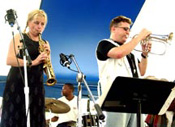 One
way the festival bonds with the community is through its series of
free Saturday afternoon downtown performances staged in a huge open-sided
tent. Five acts were presented this year, and Jane Bunnett & The Spirits
of Havana was the headline group. They ignited an overflow crowd itching
to get up and rumba. Bunnett and trumpeter/husband Larry Cramer controlled
the action while the percussive sounds and beat of Cuba filled the
air. Bunnett has always been an exciting improviser, and although
this current rhythmic direction has its improvisational limits, she
still produces stirring soprano and flute flights of fancy. A focus
of the group is Pancho Quinto, a percussionist extraordinaire. He
and singer/percussionist Ernesto Gatell dazzled the crowd with their
infectious beat while pianist Elio Villa Franca filled in the melodic
lines. Bassist Roberto Occhipinti from the very talented family of
Occhipinti's played a heavy hand in keeping the music moving forward.
Bunnett's solos were high-flying affairs. Although I feel she is more
expressive on soprano, she spiels out long, flowing improvised runs
on flute in keeping with the Afro-Cuban theme of the band. Cramer
had several opportunities at the solo helm, alternating between flugelhorn
and trumpet to give the band an extra bit of oomph. Add the drumming
of Mark McLean and the singing and dancing of Ida Sanchez and you
have a crowd-pleasing event that also had an exceptional level of
professionalism. This group in this atmosphere was well conceived,
and they did not disappoint the crowd looking for a reason to party. One
way the festival bonds with the community is through its series of
free Saturday afternoon downtown performances staged in a huge open-sided
tent. Five acts were presented this year, and Jane Bunnett & The Spirits
of Havana was the headline group. They ignited an overflow crowd itching
to get up and rumba. Bunnett and trumpeter/husband Larry Cramer controlled
the action while the percussive sounds and beat of Cuba filled the
air. Bunnett has always been an exciting improviser, and although
this current rhythmic direction has its improvisational limits, she
still produces stirring soprano and flute flights of fancy. A focus
of the group is Pancho Quinto, a percussionist extraordinaire. He
and singer/percussionist Ernesto Gatell dazzled the crowd with their
infectious beat while pianist Elio Villa Franca filled in the melodic
lines. Bassist Roberto Occhipinti from the very talented family of
Occhipinti's played a heavy hand in keeping the music moving forward.
Bunnett's solos were high-flying affairs. Although I feel she is more
expressive on soprano, she spiels out long, flowing improvised runs
on flute in keeping with the Afro-Cuban theme of the band. Cramer
had several opportunities at the solo helm, alternating between flugelhorn
and trumpet to give the band an extra bit of oomph. Add the drumming
of Mark McLean and the singing and dancing of Ida Sanchez and you
have a crowd-pleasing event that also had an exceptional level of
professionalism. This group in this atmosphere was well conceived,
and they did not disappoint the crowd looking for a reason to party.
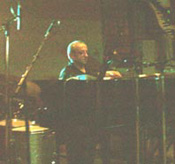 Sounds
of percussion could be heard clanging from off stage prior to Vyacheslav
Ganelin making his way to his piano, drums, and electronic paraphernalia.
He had the drum kit positioned to his right and the black boxes stationed
on the piano, so he was able to effect a one-man show quite easily.
The Russian born Ganelin, who now resides in Israel, began expelling
the evil spirits by meting out a freeform drum sequence and then glided
into a slow-paced piano dirge while simultaneously striking the cymbals.
To say his music is foreboding would be an understatement. He takes
a very somber approach to playing, and is forcibly aggressive in his
attack. Ganelin uses electronics as a real-time adjunct of his own
production. He feeds drum or piano sequences into the machine and
then creatively reinserts this augmented sound into his current direction.
His music is devoid of structure. It is a muscular form of instant
composing using his various tools, which include a volume-controlled
ring simulator that periodically could be faintly heard and seconds
later was obvious. These little effects meshed neatly into his playing,
which often became thunderously loud and frightfully violent. Ganelin
also contorted his playing into artificial sounds of other instruments
as he simulated numerous tonalities, including the soprano sax, bike
horn, pipe organ, flute, and others. Except for one brief sequence
where the electronic drum rhythms came off as too mechanical, the
use of these space-age music enhancers became an integral part of
the performance and heightened its level of originality. The freely
executed piano expressions of Ganelin, however, were the strength
and focus of this concert and unquestionably identified him as an
innovator of the first rate. This unassuming man made quite an impression
with his continual wave of ponderous inventiveness. Sounds
of percussion could be heard clanging from off stage prior to Vyacheslav
Ganelin making his way to his piano, drums, and electronic paraphernalia.
He had the drum kit positioned to his right and the black boxes stationed
on the piano, so he was able to effect a one-man show quite easily.
The Russian born Ganelin, who now resides in Israel, began expelling
the evil spirits by meting out a freeform drum sequence and then glided
into a slow-paced piano dirge while simultaneously striking the cymbals.
To say his music is foreboding would be an understatement. He takes
a very somber approach to playing, and is forcibly aggressive in his
attack. Ganelin uses electronics as a real-time adjunct of his own
production. He feeds drum or piano sequences into the machine and
then creatively reinserts this augmented sound into his current direction.
His music is devoid of structure. It is a muscular form of instant
composing using his various tools, which include a volume-controlled
ring simulator that periodically could be faintly heard and seconds
later was obvious. These little effects meshed neatly into his playing,
which often became thunderously loud and frightfully violent. Ganelin
also contorted his playing into artificial sounds of other instruments
as he simulated numerous tonalities, including the soprano sax, bike
horn, pipe organ, flute, and others. Except for one brief sequence
where the electronic drum rhythms came off as too mechanical, the
use of these space-age music enhancers became an integral part of
the performance and heightened its level of originality. The freely
executed piano expressions of Ganelin, however, were the strength
and focus of this concert and unquestionably identified him as an
innovator of the first rate. This unassuming man made quite an impression
with his continual wave of ponderous inventiveness.
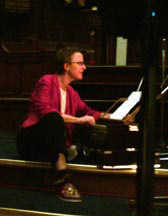 The
formation of the exquisitely beautiful Equal Interest Trio was a stroke
of genius. Myra Melford, Leroy Jenkins, and Joseph Jarman form a tight
union that produces challenging, absorbing, and uplifting music. It
is an appropriately named group as well. Each member is a compositional
contributor but more importantly is equally expressive in his or her
role as improviser and innovator. The swirling sound of Jenkins' violin
stirred the air on this night as Melford became one with her piano.
Jarman was at his adventurous best as well, often playing with robust
vigor. This unique group often breaks down into the solo or duet format.
Melford started things off aggressively, and Jenkins then joined her
with an intricate intertwining of personalities. Jarman took over
with a gripping saxophone solo, which coaxed Melford and then Jenkins
back into the fray. These three display a high level of respect for
each other. They instinctively united in a sphere of responsiveness
and expelled countless rounds of spirited originality. The song structure
was complex. It required concerted concentration to absorb the vital
nuances that emerged, but this attention was rewarded by a feeling
of elation as their musical movements washed ashore as non-stoppable
waves of brilliance. At the midpoint, Melford switched to the harmonium,
and although the sound composition changed, the interplay was consistent.
The reed-like tones of air being forced from a bellows gives the harmonium
a distinctive appeal, and combined with the flute of Jarman and high-pitched
strokes of Jenkins, had enchanting results. Melford returned to piano
for more inspired playing and the trio delved deeply into music with
weighty overtones. They held the audience spellbound. Equal Interest
is a masterful trio. As a well-deserved encore, Jarman chanted to
his compelling piece "Lifetime Visions for the Magnificent Humans",
which is documented on his upcoming album of the same title. It was
a fitting and spiritual closing to this exceptional concert. The
formation of the exquisitely beautiful Equal Interest Trio was a stroke
of genius. Myra Melford, Leroy Jenkins, and Joseph Jarman form a tight
union that produces challenging, absorbing, and uplifting music. It
is an appropriately named group as well. Each member is a compositional
contributor but more importantly is equally expressive in his or her
role as improviser and innovator. The swirling sound of Jenkins' violin
stirred the air on this night as Melford became one with her piano.
Jarman was at his adventurous best as well, often playing with robust
vigor. This unique group often breaks down into the solo or duet format.
Melford started things off aggressively, and Jenkins then joined her
with an intricate intertwining of personalities. Jarman took over
with a gripping saxophone solo, which coaxed Melford and then Jenkins
back into the fray. These three display a high level of respect for
each other. They instinctively united in a sphere of responsiveness
and expelled countless rounds of spirited originality. The song structure
was complex. It required concerted concentration to absorb the vital
nuances that emerged, but this attention was rewarded by a feeling
of elation as their musical movements washed ashore as non-stoppable
waves of brilliance. At the midpoint, Melford switched to the harmonium,
and although the sound composition changed, the interplay was consistent.
The reed-like tones of air being forced from a bellows gives the harmonium
a distinctive appeal, and combined with the flute of Jarman and high-pitched
strokes of Jenkins, had enchanting results. Melford returned to piano
for more inspired playing and the trio delved deeply into music with
weighty overtones. They held the audience spellbound. Equal Interest
is a masterful trio. As a well-deserved encore, Jarman chanted to
his compelling piece "Lifetime Visions for the Magnificent Humans",
which is documented on his upcoming album of the same title. It was
a fitting and spiritual closing to this exceptional concert.
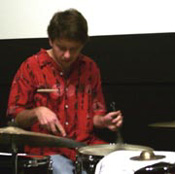 The
midnight concert matched two stellar musicians from the west and east
of Canada. Vancouver's highly creative drummer Dylan van der Schyff
fielded kinetic volleys from Montreal's Rene Lussier in an electrified
example of sound exploration. Lussier sat amid a bevy of electronic
foot pedals that he stomped to contort, interrupt, augment, and otherwise
redirect his electric output. Telepathically, van der Schyff knitted
sensitive percussion touches into the weave as he intently listened
to Lussier and interrelated as an extension of the guitarist's music.
Van der Schyff used small metal cups, little wooden sticks, rattles,
and other accessories to establish subtle ambiance and textural effects.
He bowed the edges of the drum kit, massaged their skins, and generated
reverberated sounds from the small cymbals in establishing a pattern
of non-patterned percussion. Then suddenly he exploded into full-blown
power drumming. Meanwhile, Lussier was wildly exuberant in forging
high-pitched atonal screeches from his guitar. A most unusual effect
occurred when he pulled steel wool through the strings to create sinister
yet absorbing noise music. There is a natural affinity between these
two creative minds, and their sometimes subtle but more often violent
emissions were in harmony with their free spirits. Both players bonded
to present late-night excitement for a weary yet appreciative audience. The
midnight concert matched two stellar musicians from the west and east
of Canada. Vancouver's highly creative drummer Dylan van der Schyff
fielded kinetic volleys from Montreal's Rene Lussier in an electrified
example of sound exploration. Lussier sat amid a bevy of electronic
foot pedals that he stomped to contort, interrupt, augment, and otherwise
redirect his electric output. Telepathically, van der Schyff knitted
sensitive percussion touches into the weave as he intently listened
to Lussier and interrelated as an extension of the guitarist's music.
Van der Schyff used small metal cups, little wooden sticks, rattles,
and other accessories to establish subtle ambiance and textural effects.
He bowed the edges of the drum kit, massaged their skins, and generated
reverberated sounds from the small cymbals in establishing a pattern
of non-patterned percussion. Then suddenly he exploded into full-blown
power drumming. Meanwhile, Lussier was wildly exuberant in forging
high-pitched atonal screeches from his guitar. A most unusual effect
occurred when he pulled steel wool through the strings to create sinister
yet absorbing noise music. There is a natural affinity between these
two creative minds, and their sometimes subtle but more often violent
emissions were in harmony with their free spirits. Both players bonded
to present late-night excitement for a weary yet appreciative audience.
Travel considerations forced me to miss the two concluding and very
enticing concerts on Sunday. A United Nations Millennial Jazz Summit
was held and featured Myra Melford, Jane Bunnett, Trichy Sankaran,
Maggie Nicols, Matt Darriau, Seido Salifoski, and Ken Hyder. The festival's
concluding concert was "Passages", a multi-media jazz opera written
by Guelph's exciting percussionist Jesse Stewart. It included lyrics
by jazz poet Paul Haines, vocals by Maggie Nicols, video installation
by David Rokeby, and music from Roswell Rudd, trombone (who flew in
from Paris for the set), David Mott, baritone, Anne Bourne, cello,
and of course Stewart. Not witnessing these performances was a disappointment
to me.
Still, I left Canada with the sounds of so much music swirling through
my brain. Every concert I attended had significant merit and meaningful
substance to recommend it. It was one of the most consistently satisfying
events I have attended, and I can honestly say that there were no
downturns or low points to any of the shows I observed. As Artistic
Director, Ajay Heble put together a wonderful spectrum of world artists
who met the challenge by playing inspired music with an abundance
of creativity. The Guelph Festival rightfully ranks as one of the
world's top-notch musical events, and I look forward to making my
fourth trek to this celebration of artistry in 2001.
|
|
|
|
|

